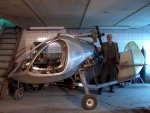Birdy,
A lot of guys used to buy timed-out Hughes rotors from military surplus. They were inexpensive, still had a lot of useful life for gyro use, and would fly a Bensen reasonably well. They just spun up the opposite direction. It drove a lot of them crazy trying to determine exactly which car starter to use to get the right spin direction for pre-rotation.
I would say the FAA is not aware of this or the question would have been modified. However, since all the questions on the Sport Pilot Gyroplane Instructor knowledge test relate specifically to the J2 (probably since it was the only thing for which they had specific and accurate specifications), I doubt any information about other configurations will ever appear in the test question bank.
This is particularly interesting, in that there is also a question about rotor blade angle and specifically its change into flight mode from pre-rotation mode that is unique to the J2. Interesting, because it conflicts with the definition of Light Sport Gyroplanes to which Sport Pilots are limited I'm sure this is an oversight.
§1.1 General definitions.
Light-sport aircraft means an aircraft, other than a helicopter or powered-lift that, since its original certification, has continued to meet the following:
(1) A maximum takeoff weight of not more than—
(i) 1,320 pounds (600 kilograms) for aircraft not intended for operation on water; or
(ii) 1,430 pounds (650 kilograms) for an aircraft intended for operation on water.
(2) A maximum airspeed in level flight with maximum continuous power (VH) of not more than 120 knots CAS under standard atmospheric conditions at sea level.
(3) A maximum never-exceed speed (VNE) of not more than 120 knots CAS for a glider.
(4) A maximum stalling speed or minimum steady flight speed without the use of lift-enhancing devices (VS1) of not more than 45 knots CAS at the aircraft's maximum certificated takeoff weight and most critical center of gravity.
(5) A maximum seating capacity of no more than two persons, including the pilot.
(6) A single, reciprocating engine, if powered.
(7) A fixed or ground-adjustable propeller if a powered aircraft other than a powered glider.
(8) A fixed or feathering propeller system if a powered glider.
(9) A fixed-pitch, semi-rigid, teetering, two-blade rotor system, if a gyroplane.
(10) A nonpressurized cabin, if equipped with a cabin.
(11) Fixed landing gear, except for an aircraft intended for operation on water or a glider.
(12) Fixed or retractable landing gear, or a hull, for an aircraft intended for operation on water.
(13) Fixed or retractable landing gear for a glider.



